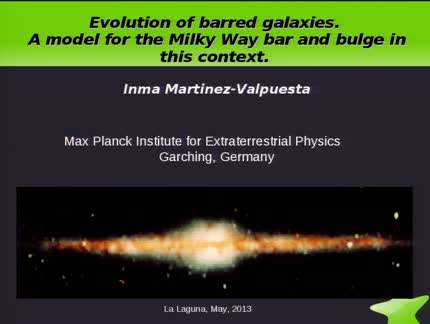Found 3 talks width keyword Galactic bars

Abstract

Abstract
The ΛCDM model predicts that galaxies originate in dark matter haloes, undergoing in their early age a process of continuous merges with other galaxies that determines the first part of their evolution. The frequency of these events decreases with time and their gradual change turns to be internally driven, becoming much slower. Bars, elongated stellar structures in the central regions of galaxies, are known to play an active role in this phase of their evolution, so-called secular.
Bars are fundamentally responsible for the redistribution of matter and the angular momentum of the baryonic and dark matter components of disc galaxies. Different simulations predict that bars get stronger and longer in time, slowing down their rotation speed.
Based on the Spitzer Survey of Stellar Structure in Galaxies (S4G) 3.6 μm imaging, we aim to study the secular evolution of disc galaxies by focusing on their stellar bar parameters. We take a large well-defined sample of about 650 nearby barred galaxies and we infer the gravitational potential from 3.6 μm images. We calculate gravitational torques, the ratio of the maximal tangential force to the mean axisymmetric radial force, in order to obtain a quantitative measure of the bar-induced perturbation strengths. In addition, we estimate the bar strength from the m=2 normalized Fourier density amplitudes and determine bar lengths both visually and by using an ellipse fitting method. Bar morphology and the interplay with spiral arms are studied via image-stacking methods as well.
In this talk I will present the statistical results derived from our measurements, providing observational evidence for the evolution of bars in accordance with the current theoretical predictions. We study bar parameters as a function of the Hubble type, addressing how the different measurements of the bar strength correlate with each other and with the galactic mass. The quality of our data allows us to probe the properties of bars in the Local Universe and connect them to the evolution of other galactic structures.

Abstract
Among the different effects of secular evolution of galaxies we find how bars influence enormously their host galaxies. For many years now, it is known how the evolution of bars will produce different boxy/peanut and X-shape bulges. In this context our Milky Way is an example of a boxy bulge, and we will present a self consistent N-body simulation of a barred galaxy that will be compared with some of the Milky Way available data. We will compare the model in terms of morphology and structure, kinematics and finally metallicity gradients.
« Newer Older »
Upcoming talks
- TODAY: Quantum Simulators for the Cosmos: From Confining Strings to the Early UniverseDr. Enrique Rico OrtegaThursday December 4, 2025 - 10:30 GMT (GTC)
- Colloquium by Junbo ZhangDr. Junbo ZhangThursday December 11, 2025 - 10:30 GMT (Aula)









